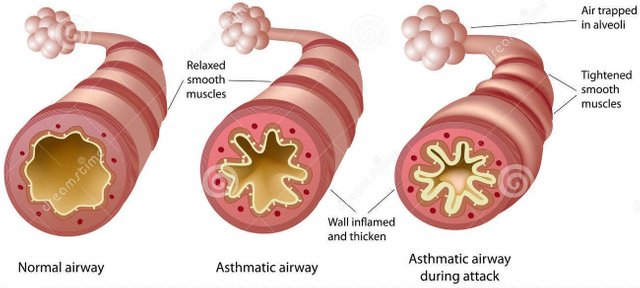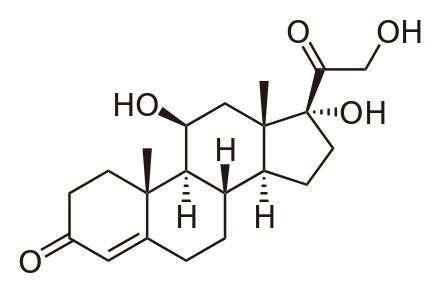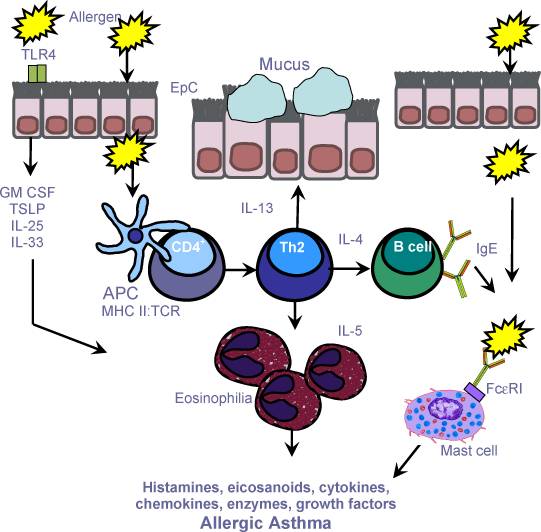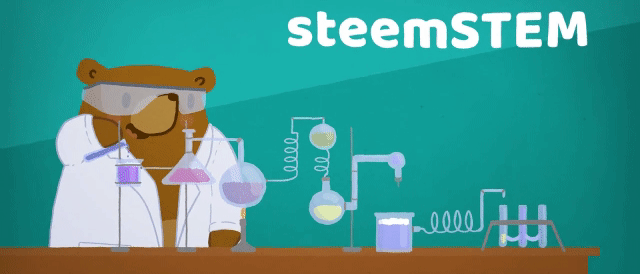Explain 3 Ways: Asthma
In this upcoming series, I will aim to explain complex scientific topics of interest, to three different audiences. The aim of this is to, not only improve my writing capabilities based upon target audience, but also provide a convenient place of information that anyone can take something useful from, whatever their background.
For example, if you have no previous science knowledge and want a more basic explanation, you could read the first section and this is catered specifically with you in mind. That being said, if it interested you, you could attempt to read the next step up and help improve your knowledge further. The general format will be an explanation in three difficulties: no prior science knowledge, A-Level science knowledge, and degree level science knowledge.
This is my first submission to @steemstem so if you have any questions, requests for future articles or feedback feel free to comment down below!
Beginner’s Explanation: Asthma

Picture 1
Asthma is a relatively common disease of the airways and affects around 5 million people in the UK.1 Although there is currently no cure for asthma, if the right treatment is taken correctly, the symptoms can be reduced significantly.
Asthma essentially boils down to the constricting of your airways and swelling of the area, resulting in symptoms such as wheezing, breathlessness and a tight chest.
Asthma is proposed to have both a genetic and environmental basis, so it is important that if you have asthma, you try and avoid your “triggers”.
Allergens, irritants and exercise are all potential contributing factors to asthma and it is based on a person to person basis as to what effects you.
Treatment includes two types of inhalers, a reliever to use quickly in the moment for relief, and a preventative inhaler that should be used regularly to help stop symptoms from reoccurring.
Intermediate Explanation: Asthma
The term asthma comes from the Greek words meaning “to breathe hard” and is a reversible obstructive airway disease that effects the trachea, bronchi and bronchioles of the lungs.
90% of all asthma is allergic asthma, however you can also get intrinsic asthma, exercise-induced asthma, nocturnal asthma and occupational asthma.
It is widely accepted that asthma has both a genetic and environmental basis, and this also differs based upon type. Allergic asthma for example is largely genetic in it’s diagnosis. Someone with allergic asthma has a hyperactive immune system that produces an inflammatory response to allergens when it shouldn’t.
On the other hand, occupational asthma refers to asthma induced by chemical pollutants or other irritants and this is an environmental cause.
The diagram below provides an informative approach to an overview of how asthma is triggered.

Picture 2
During an asthma attack, the membrane lining the airways secretes a mucus that results in inflammation and subsequent narrowing of the airways through constriction of the smooth muscle bands that respond via the involuntary autonomic nervous system. This is called bronchoconstriction.
Treatment for asthma comes in two forms, depending on whether it is being used as a long or short term solution.
In the event of an asthma attack, beta-agonists can be used to act as bronchodilators, counteracting the constriction of the airways, thus improving the symptoms of an attack. The diagram below shows the skeletal structure of salbutamol, a commonly used beta-agonist to treat asthma attacks. It activates the beta two receptors in the lungs, signalling an activation of the enzyme adenylate cyclase. This cascade of activation goes through cAMP and ultimately PKA which phosphorylates target proteins, resulting in smooth muscle relaxation.2
One key thing to note is that it is highly important to have a drug that can specifically target the beta two receptor. Beta-agonists that also activate beta one receptors induce the contraction of cardiac muscle and therefore could lead to other issues such as increased heart rate and blood pressure.

Picture 3
The second type of treatment for asthma is the use of corticosteroids. These drugs have several uses but glucocorticoids such as cortisol, seen in the diagram below, are the type of corticosteroid that can be used as a treatment measure for asthma.
These steroids act upon the hormonal pathway that is related to things like the immune-system and can both block inflammatory mediators through repression, but also induce the further activation of anti-inflammatory mediators.3 This process aims to reduce the hyperactive reaction that the airways has to allergens etcetera. However, corticosteroids are used as a longer-term approach to treatment. The hormonal system takes longer to be effected as it is related to DNA changes, unlike the nervous response in beta-agonists that can provide immediate relief.

Picture 4
Advanced Explanation: Asthma
Allergic asthma is a complex and chronic inflammatory disorder which is associated with airway hyper-responsiveness and tissue re-modelling of the airway structure.4 Faulty T-helper type 2 lymphocytes initiate an inflammatory response to normally harmless airborne allergens. Although no specific environmental or genetic factor is the sole cause of asthma, it has been found that the genetic predisposition to mount immunoglobulin type E to environmental allergens is one of the strongest risk factors associated with the development of this disease.4
The diagram below outlines an overview of some of the mechanisms involved in the asthmatic immune response. As you can see, Th2 cells play a pivotal role in the inflammatory response by secreting multiple type of interleukins to interact with several different aspects of the inflammatory system.

Picture 5
This process is too long and complicated to cover in its entirety, so I shall focus in on one particular mechanistic pathway.
Faecal pellets from the house dust mite Dermatophagoides pteronyssimus contain a cysteine proteolytic enzyme called Der p 1 that acts as an allergen.5 This enzyme is able to cleave the protein called occludin that holds together the tight junctions in-between the epithelial cells.5 This protein is then taken up by antigen presenting dendritic cells for antigen presentation and priming of CD4+ cells.
Once the naive CD4+ cells have been converted to mature Th2 cells, the inflammatory cascade begins, in which several interleukins are produced to stimulate the inflammatory response.
IL-13 is a specific interleukin that has several roles within the immune system, but in particular it has a key role in goblet cell hyperplasia.5 The Interleukin-13 protein is produced by the IL13 gene. What is interesting to note is that a natural variant on position 144 that corresponds to the amino acid glutamine instead of arginine, has been associated with an increased risk of asthma development.6
If you enjoyed this post, please don’t forget to up-vote, follow and comment! Thank you for taking the time to give it a read and I hope you have a nice day.
Donations:
BTC Address - 1JQGxuVLQf1hAz6i2dpitvGNvkTSKD8xAC
LTC Address - LdHvzzi5ZhZZr9Ce5gek9rgmJXbk78tQD7
ETC Address - 0xae041220e640Ca52BCa8644B178682fC12705cBA
NAV Address - NgQtdkT6kQaYNqEMrhc9ainga3eRv9xzXR
The steemSTEM (@steemstem) community is here to support STEM-related posts, where STEM stands for Science, Technology, Engineering, and Mathematics. If you wish your post to be noticed and curated by steemSTEM (@steemstem), then seriously consider the above. This will help us help you and shed light on posts left undervalued and unnoticed.
If you're interested in STEM and like to create STEM-related content, feel free to use the #steemstem tag and join us in our channel in steemit.chat. We'd be happy to steem around with you!

Your Post Has Been Featured on @Resteemable!
Feature any Steemit post using resteemit.com!
How It Works:
1. Take Any Steemit URL
2. Erase
https://3. Type
reGet Featured Instantly � Featured Posts are voted every 2.4hrs
Join the Curation Team Here | Vote Resteemable for Witness
Downvoting a post can decrease pending rewards and make it less visible. Common reasons:
Submit
Congratulations! This post has been upvoted from the communal account, @minnowsupport, by nathan290595 from the Minnow Support Project. It's a witness project run by aggroed, ausbitbank, teamsteem, theprophet0, someguy123, neoxian, followbtcnews, and netuoso. The goal is to help Steemit grow by supporting Minnows. Please find us at the Peace, Abundance, and Liberty Network (PALnet) Discord Channel. It's a completely public and open space to all members of the Steemit community who voluntarily choose to be there.
If you would like to delegate to the Minnow Support Project you can do so by clicking on the following links: 50SP, 100SP, 250SP, 500SP, 1000SP, 5000SP.
Be sure to leave at least 50SP undelegated on your account.
Downvoting a post can decrease pending rewards and make it less visible. Common reasons:
Submit
Being A SteemStem Member
Downvoting a post can decrease pending rewards and make it less visible. Common reasons:
Submit